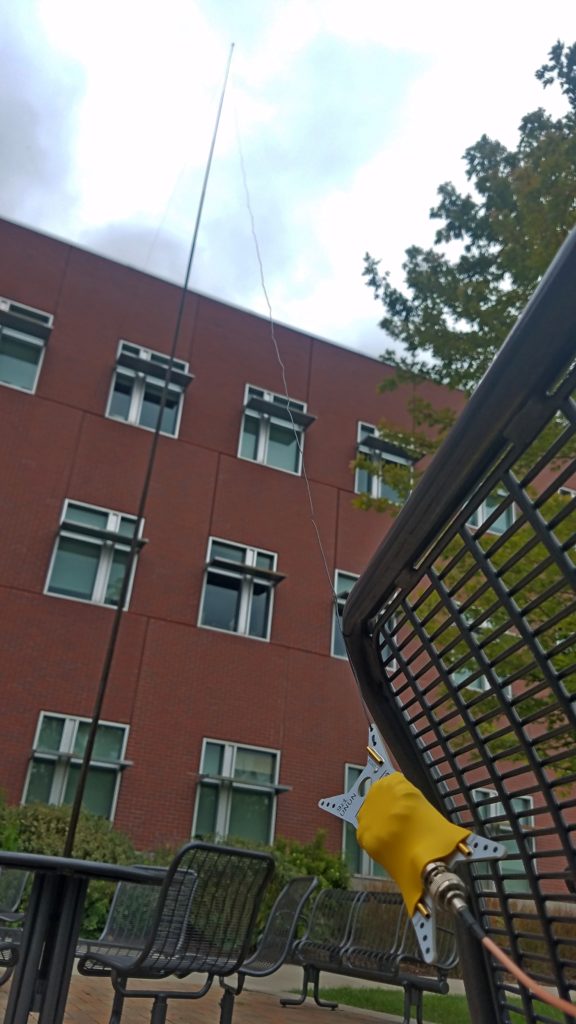As a scientist, I often try new things – and I am always ready to make mistakes. In fact, mistakes are an important part of the learning process. It is crucial, however, to make sure that they don’t discourage us from pursuing our goals. The value of every mistake is in how much we can learn from it. Thus, I will gladly share mine, hoping that it will help someone else down the road.
I planned to combine my recent testing of the Tactical Mini fiberglass telescoping mast from SOTAbeams with the activation of two parks on Platte River – K-2621 Platte River State Park and K-2614 Eugene Mahoney State Park. Both parks have nice observation towers, which are perfect operating locations, especially for low power.
While the mast performed flawlessly (I was truly amazed by how sturdy it is for its weight and length!), I had much less luck with contacts that day. I could of course blame everything on bad propagation, solar storm (which, by the way, did not quite happen to disrupt anything that Saturday), or low transmitting power of my rig. But I felt that the problem was in the antenna setup, since I already tried my Elecraft KX2 with the PackTenna in less than ideal conditions, and got reasonable results.

After getting back home with one single CW contact, and not event trying the second park, I started thinking and troubleshooting. Turned out that the root of the problem was in the way I deployed my wire antenna with the new telescoping mast. PackTenna’s wire is over 50 ft long, and the mast is only 19.6 ft fully extended. Thinking of the Hamsticks as an analogy, I simply wrapped the wire around the mast, thus trying to save some space and avoid having wires hanging around.
Well, that was a big mistake, and I am very thankful to John ABØO who kindly spent some time chatting with me on Saturday about my recent experiences, and troubleshooting the problems that I had. In reality, I missed the fact that hamsticks have a radiating element at the top – just like any loaded vertical, including the Super Antenna that I own myself. The way I deployed it, however, I basically created a coil that could be matched with a tuner, but had no radiating element whatsoever – essentially a long fancy dummy load.

Once the potential issue was identified, I was eager to try a different wire configuration and see how this will impact the station’s overall performance. I did not have time to return back to the park, and the storms were approaching quickly from the south. Thus, I grabbed my still-packed gear and headed to my workplace campus, where I knew a few quiet spots with tables, very convenient for a quick setup.

This time, I used the “inverted V” configuration, with the high point supported by the telescoping mast, and the feed point of the antenna with the 9:1 unun at one of the low points of the “V”. It is also worth noting that it takes substantially less time to deploy the antenna in the “inverted V” configuration (and to pack it back too!), rather than to wrap it around the mast.

Once I fired up the radio, it tuned the wire flawlessly to SWR 1.0-1.1:1. I heard stations with no problem – in fact, I was particularly pleased by the audio quality, something that I first noted during my last little adventure with the KX2. Needless to say the the performance of my station with this antenna configuration was a totally different story! I was able to hear much more stations on the air, and was picked up quickly by the Reverse Beacon Network when I threw in a quick CQ on CW.
In just 15 minutes that I had before running back home ahead of the rain that rolled in, I reached stations in ID, LA and FL on 20 meters – not bad at all for 10 W and a random wire! Keep in mind that this test was performed with an intense band of thunderstorms less than an hour away to my south – a factor that significantly impacted my operations not too long ago. My faith in low-power SSB was definitely restored, and I’m waiting for a dry weekend day to return back to those two parks.